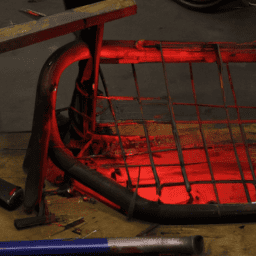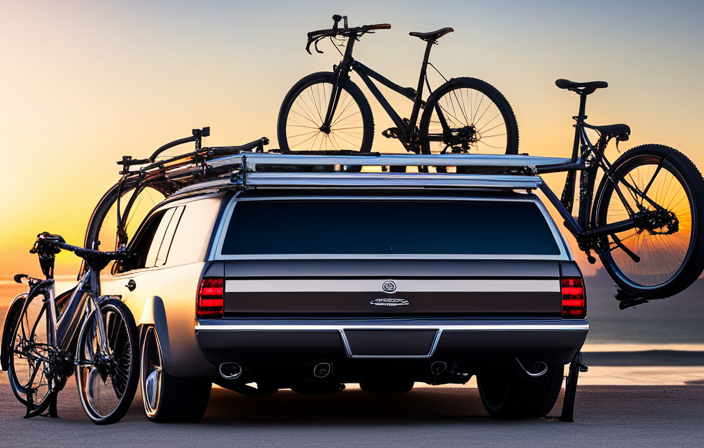As I bike along the path, feeling the breeze through my hair and the warmth of the sun on my skin, I’m filled with a sense of freedom and vitality. However, a quick way to dampen such an enjoyable experience is by getting a punctured tire. Thankfully, replacing a bike tube is quite a straightforward process that any cyclist can master.
In this article, I’ll share with you my tried-and-true method for changing a bicycle tube quickly and easily.
First things first, you’ll need to gather the necessary tools. You’ll need a tire lever, a new tube, a pump or CO2 inflator, and a wrench to remove the wheel. I always keep these tools in a small pouch under my bike seat, so I’m always prepared for any unexpected flats.
Once you have everything you need, it’s time to get started.
Key Takeaways
- The necessary tools for changing a bicycle tube include a tire lever, a new tube, a pump or CO2 inflator, and a wrench.
- It’s important to determine the type of tube needed (Presta or Schrader) and to keep the tires inflated and free of debris to prevent flats.
- When changing a tube, it’s also important to inspect the tire for damage or wear, patch or replace if necessary, and properly dispose of the old tube.
- To ensure proper tire function, it’s crucial to choose the right tire size and type for the terrain, check for sharp objects or debris, and maintain proper inflation levels.
Gather the necessary tools
You’ll need to grab some tools before you can replace your bike tube. First, you need to determine the type of bicycle tube you have.
You can do this by checking the sidewall of your tire for the tire size and valve type. There are two types of bicycle tubes: Presta and Schrader.
Presta valves are long and skinny with a locking nut on top, while Schrader valves are short and stubby with a spring-loaded valve core. Make sure you have the correct valve type before you start.
To prevent a flat tire in the future, make sure you always keep your tires properly inflated and check for any debris or sharp objects on the road. You can also use tire liners or puncture-resistant tires to add an extra layer of protection.
Once you have determined the type of tube and gathered the necessary tools, you can move on to removing the wheel.
Remove the wheel
First things first, gotta take that wheel off if you wanna get this thing fixed up and ready to ride again! Depending on your bike, you may have a quick release or a bolt on wheel. If you have a quick release, simply flip the lever and loosen the nut on the opposite side of the wheel. If you have a bolt on wheel, use a wrench to remove the nuts on either side of the axle.
Once the nuts or lever have been loosened, gently lift the wheel out of the frame. Be careful not to damage the bike frame during removal – avoid scratching the paint or pulling on any cables or brake lines.
Now that the wheel is off, it’s time to move on to the next step: removing the old tube.
Without delay, let’s dive into the process of removing the old tube and getting our bike back on the road.
Remove the old tube
Once the wheel is off, it’s time to deflate the old tube like a balloon losing air. I use a tire lever to pry the tire bead off the rim, then I reach inside and pull out the old tube.
Before disposing of the old tube, I check it for any punctures or wear. If the tube is still in good condition, I keep it as a spare.
Proper tube disposal is important. I make sure to dispose of the old tube in an environmentally-friendly way.
Checking for tire damage is also crucial; I inspect the tire for any punctures, cuts, or tears. If I find any damage, I patch it up or replace the tire.
Once I’m satisfied that the tire is in good condition, I’m ready to install the new tube.
Install the new tube
Ready to put in the new tube? It’s time to get your hands dirty and start installing it with care and precision. Follow the steps below to ensure a smooth and safe ride:
-
First, inspect the tire for any sharp objects or debris that may have caused the flat. This is important to prevent the new tube from getting punctured.
-
Apply a thin layer of talcum powder or baby powder on the new tube to prevent it from sticking to the tire and causing friction.
-
Insert the new tube into the tire, making sure that it is not twisted or pinched. Start by inserting the valve stem through the hole in the rim.
-
Carefully inflate the tube until it is firm but not too tight. Check the tire for any bulges or unevenness, which may indicate that the tube is not properly seated.
Proper inflation is crucial for a comfortable and safe ride. Make sure to inflate the tire to the recommended pressure, which can be found on the sidewall of the tire. After inflating, check the tire for any leaks or bulges. If you notice any issues, troubleshoot by checking the valve stem for leaks or making sure that the tube is properly seated.
Once you are confident that the tube is properly inflated and installed, you can move on to reinstalling the wheel and tire.
With the new tube in place, it’s time to get the wheel and tire back on the bike.
Reinstall the wheel and tire
Now that you’ve successfully installed the new tube, it’s time to get the wheel and tire back on the bike and hit the road like a pro. Before you do, you need to make sure that you’ve chosen the right tire size and type for your bike.
Check the sidewall of your tire for the dimensions and match them with the new tire you’ve purchased. Additionally, consider the type of tire you need for the terrain you’ll be riding on. For example, if you’ll be riding on rough terrain, you’ll need a tire with more tread and a thicker wall for added protection.
Once you have the right tire, it’s time to reinstall it. Begin by aligning the tire with the valve stem and sliding it onto the rim. Make sure the tire is seated evenly on both sides of the rim. Then, use your hands to gently push the tire onto the rim, making sure it’s snug.
Next, inflate the tire to the recommended pressure, which can also be found on the tire’s sidewall. Finally, check the tire for any damage or cracks, and give it a quick spin to make sure it’s running smoothly. With proper tire inflation and careful inspection, you’ll be ready to ride your bike like a pro.
Frequently Asked Questions
How do I know if my bicycle tube needs to be changed?
To determine if my bike tube needs replacement, I inspect for signs of wear and tear such as cracks, punctures, or bulges. If the tire is worn unevenly or has frequent flats, it may be time to replace the tube. Regular maintenance and troubleshooting can prevent these issues.
Can I use any type of bicycle tube or do I need a specific one for my bike?
Choosing the correct tube compatibility is crucial for optimal performance. I always measure the size of my current tube before purchasing a new one. It’s essential to find the right size to avoid leaks or blowouts.
Do I need to replace the tire as well as the tube?
When replacing a bike tube, it’s crucial to consider whether the tire needs replacing too. Patching a tube is cheaper, but replacing it ensures lasting durability. Tubeless tires are worth the investment for avid cyclists seeking a smoother ride.
How often should I check my bicycle tubes for wear and tear?
I check my bicycle tubes for wear and tear every 1-2 months or after riding on rough terrain. Signs of wear and tear include cracks, bulges, and punctures. Regular frequency of inspection prevents unexpected flat tires.
What should I do if I don’t have the necessary tools to change my bicycle tube?
If I don’t have the necessary tools to change my bicycle tube, alternative solutions could include using a patch kit or taking it to a bike shop. Borrowing tools from a friend or neighbor is also an option.
Conclusion
Well, that’s it folks! You now have all the knowledge you need to change a bicycle tube like a pro.
Remember, it’s all about being prepared with the right tools and taking your time to do it right. Changing a bike tube can be like a journey, with twists and turns along the way.
But with practice and experience, you’ll soon find yourself cruising down the road with ease. So, grab your bike, your tools, and get ready to embark on your next adventure, because there’s no road too bumpy and no obstacle too high for a determined cyclist.
Happy riding!









